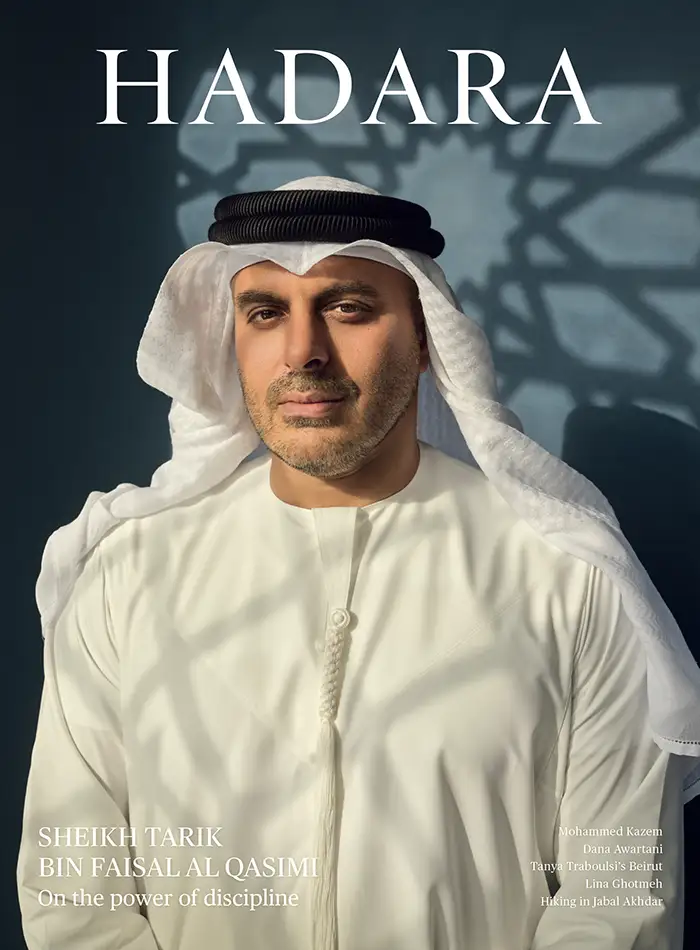The slow boat to Aswan
Nour El Nil’s distinctive dahabiyas offer a mindful way to travel Egypt’s storied river.
By Peter Drennan
There are faster ways to reach Aswan, just 159 kilometres south of where we gather in Esna on the west bank of the mighty Nile. But this journey is not about speed.
Nour El Nil is one of many river-cruise companies that ply the Luxor-to-Aswan stretch of Egypt’s storied waterway, connecting its tourist meccas, but none does it as gracefully, or as slowly. By a long, gentle arc in the river, we assemble to board a boat for the five-day voyage to Egypt’s parched south.
Its seven (soon to be eight) dahabiyas—shallow-bottomed, barge-like vessels—move upstream in flotilla, mostly under distinctive red-and-white-striped sail. Dahabiyas have sailed the Nile for millennia—similar craft are depicted in the tombs of the pharaohs. They were the standard for passengers travelling the Nile, too, until the 1870s when they were made obsolete by the arrival of steam power. For much of our voyage, the large, triangular sails are unfurled. We are towed from time to time by a supporting flotilla of sturdy blue-and-white tugboats when the breeze drops and the Nile turns a calm, steely grey.
For Nour El Nil’s three founders—French, Mexican, and Egyptian—speed, or rather the lack of it, is the point. Bound by a shared passion for Egypt, they built their business on a simple idea: to help travellers experience this legendary river in an authentic way. They reintroduced dahabiyas to the Nile two decades ago. The Egyptian partner, Memdouh Khalifa, is a sailor and boat builder, and the French partner, interior designer Eleonore Kamir, furnished the interiors. All-white en-suite cabins downstairs contrast with the bohemian striped daybeds and rugs on the open upper deck. The company has picked up imitators since, but none has matched its blend of simplicity and understated luxury.
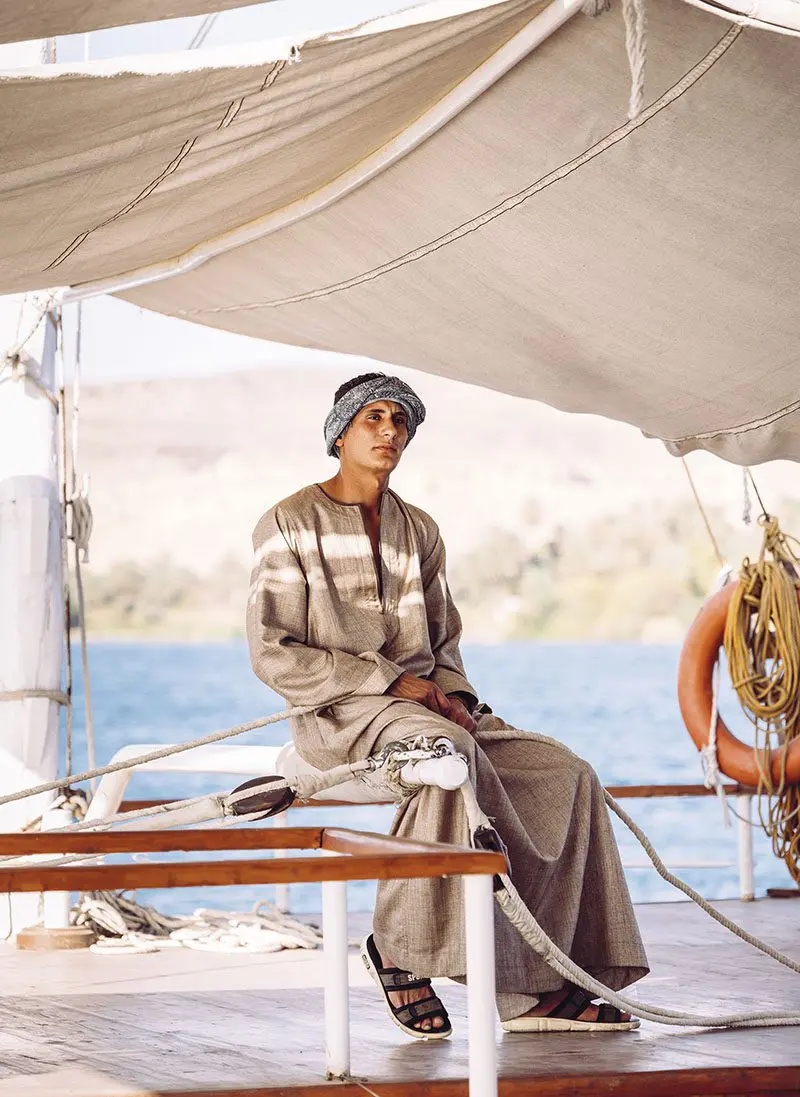
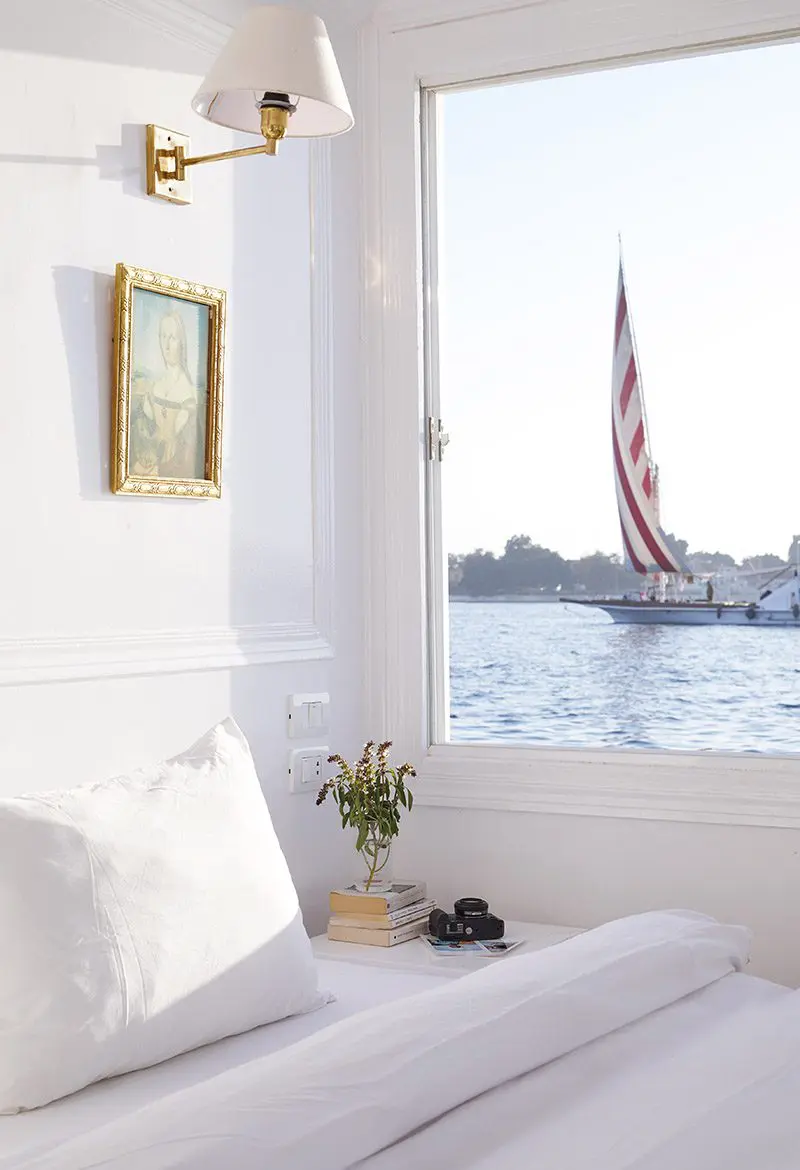
Top, crew members sit alert on the long wooden tiller, making minimal adjustments with shifts in their bodyweight. Above, windows in the all-white cabins on the lower deck offer water-level views across the Nile. The dahabiyas move upstream in flotilla. Top photo by David Uttley; Cabin by Dylan Chandler.
The partners are passionate, too, about engaging the communities we pass. The onboard staff and excellent guides, who decipher the many temples and tombs we visit, are treated like (and often are) family.
On our first morning, Kamir joins us for breakfast, which, like all meals, is served communally. She has been coming to Egypt for 45 years, and swims as often as she can in the Nile. One morning, we follow her, barefoot, to the southern point of an island where our boats have moored, to a gap in the foliage at the water’s edge. We jump in and are propelled quickly downstream by the strength of the current, sweeping us past the tugs and dahabiyas, to the cheers of the few guests who have stayed on board. One by one, we reach out for the yellow ladder protruding from the water and scramble aboard the final tug, exhilarated.
Our boat, Adelaide, has 18 guests, ranging in age from not yet 25 to almost 80. There is the matriarch, now Brazilian but once Hungarian, who tells stories of her family’s escape, and then exile, from communist Eastern Europe. The newlyweds, from San Francisco, Los Angeles, and Mexico. The Australian airline pilot. The French event organisers. The Italian coder, young and athletic, who teaches us backgammon and blushes when he speaks. A group as diverse as it is worldly. As dusk descends across the Nile, casting shadows across the deck and plunging the banks beyond into blackness, table-wide conversations splinter into intimate discussions.
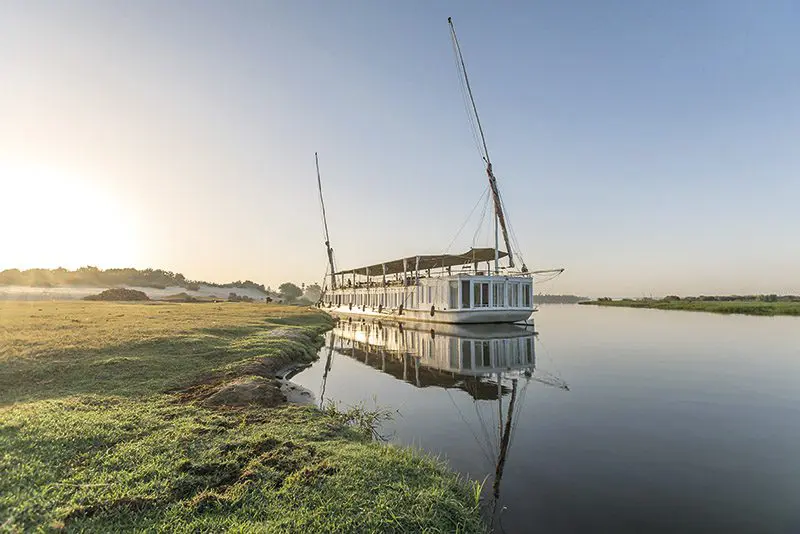
Verdant banks and the islands that rise from the river offer an overnight mooring for the dahabiyas. Guests descend narrow wooden gangplanks to walk barefoot on the banks. Photo: Tribex Digital.
The route from Esna to the bridge at Aswan meanders between lush green banks, pierced occasionally by minarets, pump stations, and dusty villages where children wave from the water’s edge. Beyond these ribbons of green rise hills of honey-colour sandstone. On the river, fishermen cast yellow nets from rudimentary fishing boats that sit low in the water, their blue oars resting on the surface. Islands covered with reeds and grasses rise from the river, offering an overnight mooring for the dahabiyas and tugs.
Water buffalo sit in the shallows where the Nile meets the banks, undisturbed by our cameras. Sacred ibises, numerous in the swampy areas of the Upper Nile, probe the mud for snails. Donkeys are ubiquitous, staying close to where we climb down the wooden ramp for sunset walks. One afternoon, as the sun begins to dip, a mighty flock of great white pelicans flies low and soundless over the water.
On board it is often quiet, too, beyond the whir of the fans that offer scant succour from the September heat. Occasionally the silence is pierced by the blast of a train horn—the Cairo-to-Aswan line shadows the Nile for much of its length—the engines, passenger cars and freight containers incongruous in this otherwise timeless setting. On deck, guests recline on the striped daybeds, which Kamir replaces often as they are bleached by the harsh sun. A crew member in a pale blue jalabiya sits alert on the long wooden tiller, making minimal adjustments with shifts in his bodyweight.
Egypt’s treasures are timeless, too, and our itinerary is peppered with visits, including to some that are off limits to the larger, diesel-powered cruisers that frequently pass us. Before boarding in Esna, we visit the ancient Temple of Khnum, the ram-headed god of fertility. Nine metres below street level—it was buried by 15 centuries of desert sand and debris—it has a dark, atmospheric hall where a ceiling decorated with celestial scenes (still undergoing renovation) is supported by 24 columns carved with temple rituals.
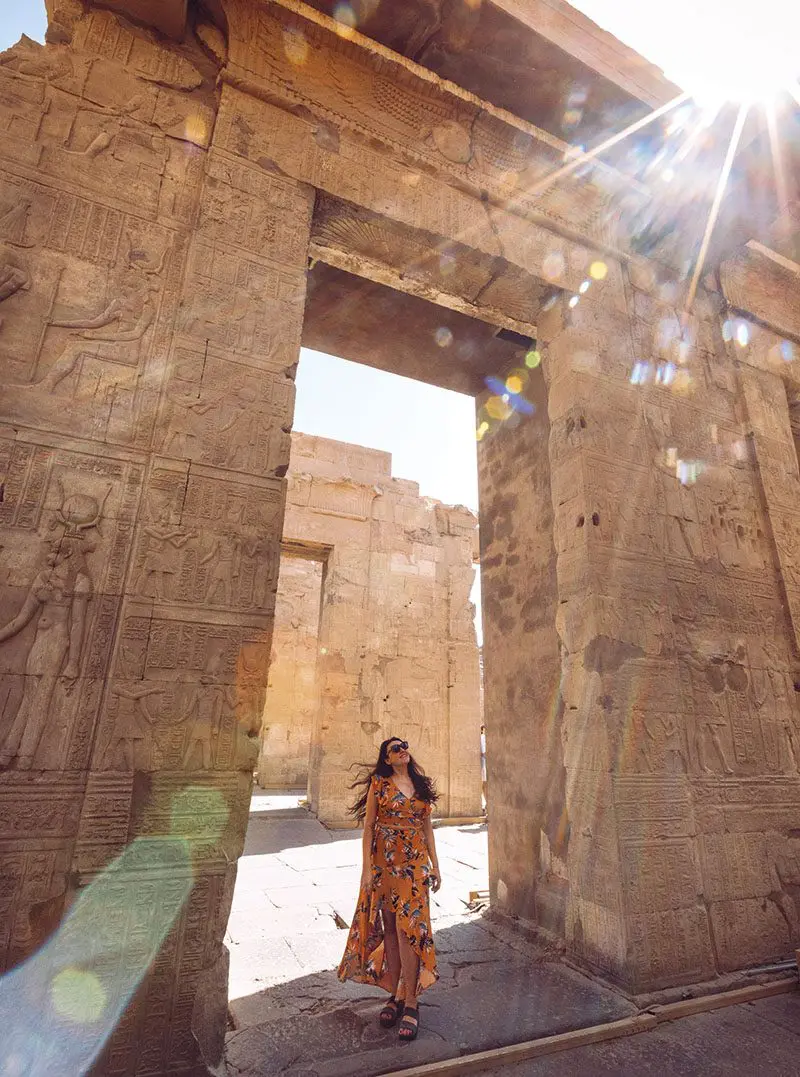
The itinerary is peppered with visits to the treasures that line the Nile, including the Temple of Kom Ombo. Built during the Ptolemaic dynasty (180–47 BCE), it sits at a strategic location on a bend in the river. Photo by David Uttley.
On the second day, we dock first in El Kab and in the afternoon in Edfu. El Kab, on the east bank of the Nile and once the capital of Upper Egypt, is home to the temple of Nekhbet, the vulture goddess, as well as a row of richly decorated tombs cut into a hillside that date back to the New Kingdom (1550–1069 BCE). At Edfu, the important Greco-Roman temple dedicated to the god Horus is among the best preserved of all Egyptian temples. On the third night, we tie up at the foot of the floodlit temple of Gebel Silsila. Here, the Nile is at its narrowest, passing between steep cliffs. During the New Kingdom, workers hacked huge blocks from the sandstone quarries here, floating them down the Nile to Luxor, where they were used for the temple complex of Karnak, among others.
On the fifth day, we visit one of the Nile Valley’s greatest treasures, the Temple of Kom Ombo. Built during the Ptolemaic dynasty (180–47 BCE) at a strategic location on a bend in the river, where Nile crocodiles would once bask in the sun (mercifully for us swimmers, they are now held behind the Aswan Dam, some 48 kilometres upstream), it is unique in Egypt, in that it is dedicated to two gods—the crocodile-headed god Sobek and the falcon-headed god Horus. The structure combines two temples in one, with each side having its own gateways and chapels.
Then it’s back on board for the final leg of the journey, to the bridge at Aswan. With the wind low, the sturdy tugs take up the strain. But late in the afternoon, as the heat of the day ebbs away and golden-hour light bathes the deck, the wind picks up and the sails are unfurled.
The journey, as the partners intended, has been slow, memorable, and magical. We came to discover Egypt, its storied waterway, and its priceless treasures. But what we found was ourselves, and each other. Is anything worth more than that? For more, go to nourelnil.com
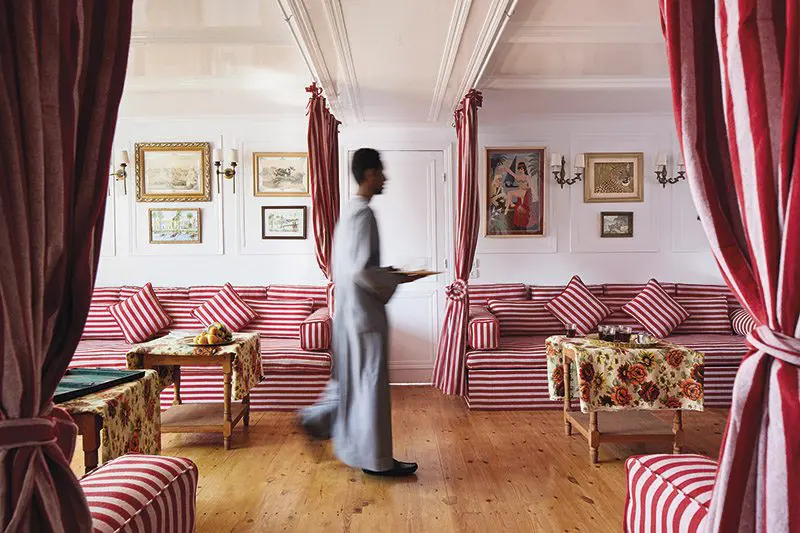
The red and white stripes of the quiet onboard library. Photo by Dylan Chandler.
Opening image by Tribex digital





